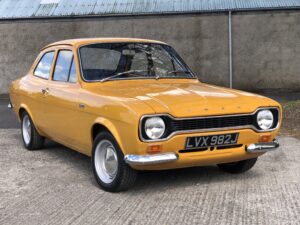Mark One Escort RS about to shock auction charts
 Scarcely an automotive icon, a descript best left on either Mini, or Beetle, writes Iain Robertson, the Escort was not even a ‘new’ car, when it first popped-up in Ford dealerships in 1967-1968, but it left an immense impression on all manner of people, from company sales reps to stock car drivers and a wealth of rallyists worldwide.
Scarcely an automotive icon, a descript best left on either Mini, or Beetle, writes Iain Robertson, the Escort was not even a ‘new’ car, when it first popped-up in Ford dealerships in 1967-1968, but it left an immense impression on all manner of people, from company sales reps to stock car drivers and a wealth of rallyists worldwide.
Being born in the mid-1950s put a chap squarely in the sights of the Ford marketing machine, a department that was growing rapidly in a new era, and Escort was a tentative tap into the future. The first ‘Escort’ was a handy windowed-van version of the mid-1950s’ Anglia 100E, which lent itself to mild customisation, with faux wood panelling, stripes and chromium plate. The Anglia from which Escort grew was the unusual 105E, with its notchback rear window, front fenders and tail-fins. The subsequent big-seller shared virtually all of the 105E’s metal pressings bar the exterior skin. Yet, before it became known as the ‘Mark One’, it became a huge sales success.
Sold in 1.1 and 1.3-litre Kent petrol pushrod engine forms, Escort became the darling of the cop shop, the company fleet and private driveways across suburbia. It was a wee toughie, being built sturdily at Ford’s Dagenham plant and even sold in limited volume, uprated Lotus form, complete with the firm’s 1,558cc, 105bhp twincam motor propelling it. However, the ‘machine’ was all fired-up and Ford perceived a need to satisfy the motorsport scene…Escort was ideal. In big-winged, fat-tyred, engine-tuned form, it became the runaway leader, with rallyists ditching their Cortinas for the lighter, wieldier and more agile Escort. Ford engaged with ubiquitous Cosworth Engineering and the Belt Driven family of 16-valve twincams was formed, with units as small in capacity as 1.0-litre but up to 2.1-litres slotting beneath the bonnets of Escorts (and also Capris of the era). The BDA(-type) was 1.6-litres and produced 115bhp, enough to whizz an Escort road car from 0-60mph in around 8.6s, twin Dellorto carburettors gurgling charismatically, certainly quick enough for the period and indicative of the low kerbweight inherent to the car.
Although some of the BDG, or BDX alternatives became the flaming up to 300bhp options in forest and tarmac rallying, the remaining unconverted examples, reducing in number annually as rallying casualties grew, were squirrelled away by their sometime proud owners, only to see daylight several years later, as and when the auction market ebbed and flowed. Values have continued to escalate and, while the original £1,500 RS joined the ranks of the non-depreciating assets, pre-sale estimates have usually been slaughtered by seriously large margins. The car you see here is actually rather special.
Plated ‘982’, a run of ‘LVX’ registered Escorts became renowned with Scandinavian superstars making their names on the streets of Monte Carlo, Cagliari, Wellington and Cork, although ‘982’ was only ever the ‘Show Car’, complete in every detail but, more importantly, unmodified. In fact, it had been sold to a Northern Irish enthusiast, whom now wishes to cash it in. The auction catalogue suggests it is worth £65,000…however, I have a sneaking suspicion that the hammer will probably descend closer to £200,000, in the process establishing a new World Record for an original specification, competition related example of the RS genre. It is unique. In fact, the only work carried out on it has been a restored interior, rebuilt engine and a fresh paint job, all to standard specification, not bad for a 50+ year old.
While some classic cars need additional bolstering to awaken the market to their existence, previously hidden gems, such as this yellow Escort, can afford some remaining anonimity. As a rally fan, I recognise the car’s importance but I also appreciate that its potential worth is going to be a lot more than I can afford.


